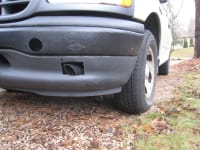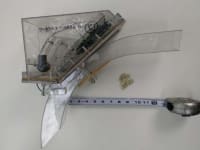The Integrated Coefficient Enhancement (ICE) is a unique concept that addresses vehicle dynamics during panic events. State-of-the-art safety technologies in concert with an aerodynamic/mechanical delivery devise and high tech ceramic tractive medium (TM), come together in real time to greatly improve friction forces during a panic event. The result is greatly reduced stopping distances and turning radii at any speed on most road surfaces including ice, snow, wet and dry pavement.
The ICE consists of three main aspects: Electronics, Delivery Apparatus, and Tractive Medium.
Electronics
State-of-the-art safety systems such as ABS, ESC, LiDAR, and radar activate and control the ICE in real time.
Delivery Apparatus
Each of two aerodynamic/mechanical delivery units are located behind the vehicle’s front bumper, in front of its wheels and have three main components: an air duct, hopper, and a powered gate valve.
Air duct
The heart of the delivery system is a five-centimeter diameter air duct that extends horizontally back from an opening in the front bumper before turning down to vertical in a sweeping elbow. This air duct captures slipstream air as the vehicle moves forward and utilizes it to deliver the tractive medium to the road. An opening at the top of the sweeping elbow connects to the hopper above. A venturi built into this duct, just forward of the elbow, creates a low-pressure zone at the opening to the hopper above. This precludes the entry of any rain and moisture that would be entrained in the slip stream air from entering the hopper.
Because the speed of the air in this duct matches the vehicle’s ground speed, TM introduced into this air stream is effectively delivered to the road surface just in front of the vehicle’s front wheels at any speed without any additional moving parts.
Hopper
Located just above the sweeping elbow of the air duct, the small hopper holds about two kilograms of TM. It is easily refilled by the driver/owner.
Gate Valve
Below the hopper a rotating gate valve controls the flow of the TM’s introduction into the air duct. A rotary actuator, taking its orders from the electronic systems, powers this valve open and closed during a panic event metering the proper flow of TM relative to the ground speed of the vehicle.
Tractive Medium
ABS and ESC are limited by the laws of physics to static coefficient of friction. The all-important shape of the TM ensures it can increase friction forces well beyond those limits. The overall disc shape ensures that it will lie flat on the road with its points both up and down. The points on top grip the tire while the points underneath bite into the road surface increasing the hysteretic forces well beyond that which are possible for tires alone. The high-tech ceramic material with a compressive strength of 80,000 psi stands up to the tire/road force demands.
The path of TM created by the ICE remains on the road for the benefit of following traffic.
Video
Like this entry?
-
About the Entrant
- Name:Jim Skarie
- Type of entry:individual
- Patent status:patented








